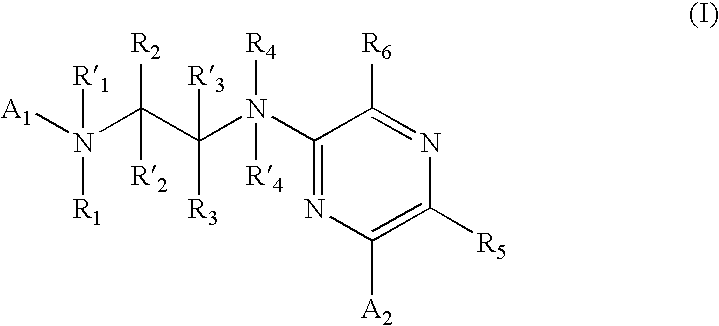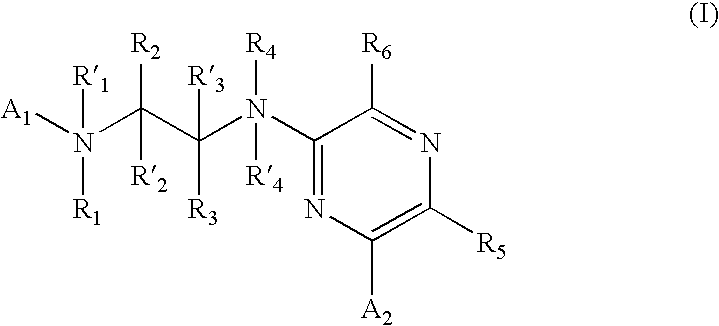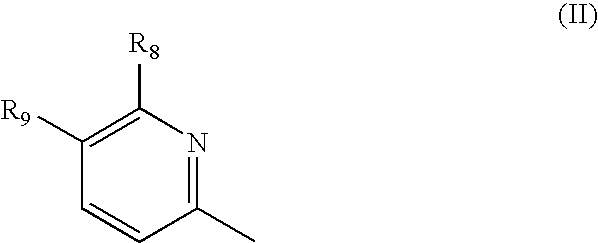Pyrazine based inhibitors of glycogen synthase kinase 3
a glycogen synthase and inhibitor technology, applied in the field of pyrazine compounds, can solve the problems of cardiovascular disease, kidney failure and blindness, and increased glucose in the blood, and achieve the effects of reducing the risk of cardiovascular diseas
- Summary
- Abstract
- Description
- Claims
- Application Information
AI Technical Summary
Benefits of technology
Problems solved by technology
Method used
Image
Examples
example 1
Characterization and Purification Methods
[0107]Compounds of the present invention were characterized by high performance liquid chromatography (HPLC) using a Waters Millennium chromatography system with a 2690 Separation Module (Milford, Mass.). The analytical columns were Alltima C-18 reversed phase, 4.6×250 mm from Alltech (Deerfield, Ill.). A gradient elution a was used, typically starting with 5% acetonitrile / 95% water and progressing to 100% acetonitrile over a period of 40 minutes. All solvents contained 0.1% trifluoroacetic acid (TFA). Compounds were detected by ultraviolet light (UV) absorption at either 220 or 254 nm. HPLC solvents were from Burdick and Jackson (Muskegan, Mich.), or Fisher Scientific (Pittsburgh, Pa.). In some instances, purity was assessed by thin layer chromatography (TLC) using glass- or plastic-backed silica gel plates, such as, for example, Baker-Flex Silica Gel 1B2-F flexible sheets. TLC results were readily detected visually under ultraviolet light, ...
example 2
[0112]Synthesis of 3,5-dibromopyrazine-2-ylamine
[0113]11.2 ml of bromine in 38 ml of acetic acid were slowly added at 15° C., while stirring, to a solution of 2-aminopyrazine (9.5 g, 100 mmol) and sodium acetate trihydrate (32.6 g) in 150 ml of acetic acid. The addition required about 1-2 hours and it was carried out in the dark. The reaction mixture was stirred at room temperature overnight. The solution was concentrated in vacuo and the brown viscous residue was poured into ice water (150 ml) under stirring. Aqueous 20% sodium hydroxide was added in order to obtain a pH of 8 and extracted with ethyl acetate (4×75 ml). The combined organics were washed with water (2×50 ml) and brine (1×50 ml), dried and concentrated. The crude product was purified by column chromatography (2:1 hexanes and ethyl acetate) to provide the desired compound.
[0114]HPLC: 8.7 min (98% pure)
[0115]MS: MH+=251.8 C4H3Br2N3=250.8 g / mol
example 3
Synthesis of 3-(2,4-dichlorophenyl)-5-bromopyrazine-2-ylamine
[0116]
[0117]To a solution of dibromopyrazinyl amine (1 g, 3.95mmol) in benzene (25 ml), Pd(PPh3)4 (230 mg, 0.02 mmol), sodium carbonate (840 mg, 7.9 mmol) in 4 ml of water and dichlorophenylboronic acid (830 mg, 4.3 mmol) in 1ml of ethanol were added. The mixture was refluxed under vigorous stirring overnight. The solution was concentrate and taken into ethyl acetate (50 mL) and water (20 ml). The organic layer was separated and the aqueous layer was extracted with ethyl acetate (2×50 ml). The combined organics were washed with water (1×25 ml) and brine (1×30 ml), dried, and concentrated. The crude was purified by column chromatography (4:1 hexanes and ethyl acetate) to provide the desired as the only isomer.
[0118]HPLC: 13.6 mm (98% pure)
[0119]MS: MH+=317.9 C10H6BrCl2N3=316.9 g / mol
PUM
| Property | Measurement | Unit |
|---|---|---|
| temperatures | aaaaa | aaaaa |
| pH | aaaaa | aaaaa |
| temperature | aaaaa | aaaaa |
Abstract
Description
Claims
Application Information
 Login to View More
Login to View More - R&D
- Intellectual Property
- Life Sciences
- Materials
- Tech Scout
- Unparalleled Data Quality
- Higher Quality Content
- 60% Fewer Hallucinations
Browse by: Latest US Patents, China's latest patents, Technical Efficacy Thesaurus, Application Domain, Technology Topic, Popular Technical Reports.
© 2025 PatSnap. All rights reserved.Legal|Privacy policy|Modern Slavery Act Transparency Statement|Sitemap|About US| Contact US: help@patsnap.com



